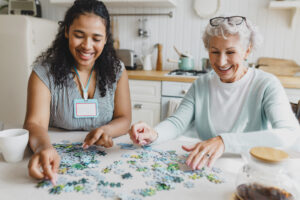Has the older adult that you care for suffered a stroke? If so, then you know that communicating with them post-stroke can be particularly challenging—both for you and for them. In addition to potentially limiting the strokes victim’s speech, these events can cause changes in memory, behavior, and physical abilities.
If your loved one was in the hospital or at a rehabilitation center after a stroke, they probably had healthcare professionals who were experienced with their condition. These professionals knew ways to learn your loved one’s needs and meet them. However, once a patient is discharged, it is up to the family and any hired caregivers to take up this role, and that means increasing communication. Read on for tips on how to make it easier on both of you.
Communicating with a Stroke Patient
A common side effect of strokes is aphasia[1. “Aphasia,” https://www.mayoclinic.org/diseases-conditions/aphasia/basics/definition/con-20027061], which can have a negative effect on the victim’s ability to speak and understand. This is often as equally frustrating for the patient as it is for the caregivers. Then there’s language apraxia[2. “Apraxia of speech in adults,” https://www.asha.org/public/speech/disorders/ApraxiaAdults/], in which the left side of the brain (the part most of us use to speak and understand language) is damaged during a stroke.
Aphasia and apraxia are only a few of the consequences of a stroke that can make communication difficult. However, the following advice can still be applied to these and other side effects:
Choose a quiet place to communicate: Exchanging words and ideas is difficult enough in noisy, crowded spaces, but for a stroke victim it is even more so. These “quiet” places extend to turning off the TV, radio or other devices that might make loud and distracting sounds.
One-on-one is best: If many different people are trying to talk to your loved one at the same time, confusion is sure to result. A stroke victim may have trouble following conversations between people. Discussions solely between you and your loved one (and perhaps a home health aide) usually work better.
Show, don’t tell: Make sure that your loved one can see you when you speak. This probably means standing on the side of their body that was not affected by the stroke. If your loved one does have aphasia, they may still be able to tell from your gestures or facial expressions what you intend to say.
Adjust your speech: Talking more slowly, quietly, using pauses, simple words, short sentences, and the like will go a long way in helping your loved one’s comprehension. You may also need to repeat things over and over, or in different ways, until your loved one remembers and understands them.
Use tools: Sometimes, a visual aid can be an effective tool to make yourself understood. Your loved one may not remember or be able to say the word you want, but they might recognize the person or object it refers to. You can use pictures, calendars, photos, or anything else you think would help in this way.
One thing at a time: It’s best not to ask your loved one to both listen to you and perform another task at the same time (unless you’re giving them an instruction, such as, “Please pick up this glass”). After strokes, the brain can have trouble processing more than one piece of information at once.
You Don’t Have to Provide All the Caregiving for Stroke Victims
Providing caregiving for stroke victims can be a full-time job—one which you may be ill-equipped to take on right now. Couple this with the fact that their rehabilitation may take weeks or months (without getting them back to their prior level of functioning), and you may find yourself overwhelmed. The good news is that this doesn’t have to be the case. Help is available, either through the community or privately hired home health agencies. The bottom line is, don’t be afraid to ask for support, so that you can get back to communicating with your loved one and showing them how much you care.
If you are unsure of how to best help an aging loved one, the trained and compassionate staff at the Institute on Aging is here to help you make that decision and gain the best in at-home care for older adults. Contact us to find out more.







